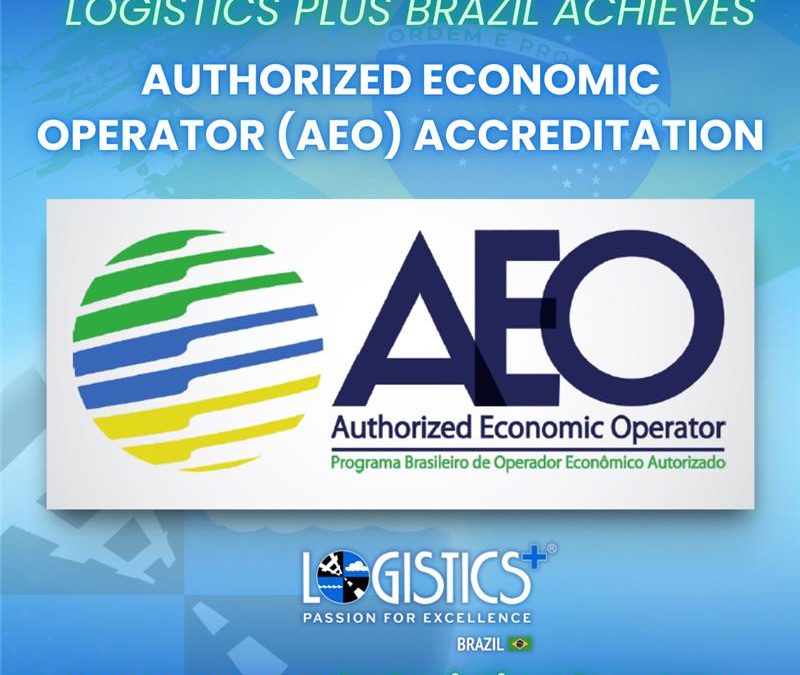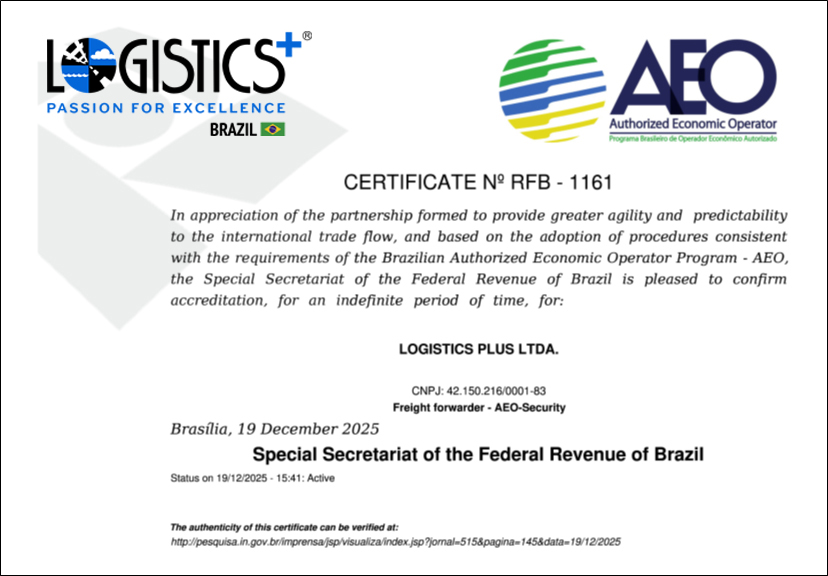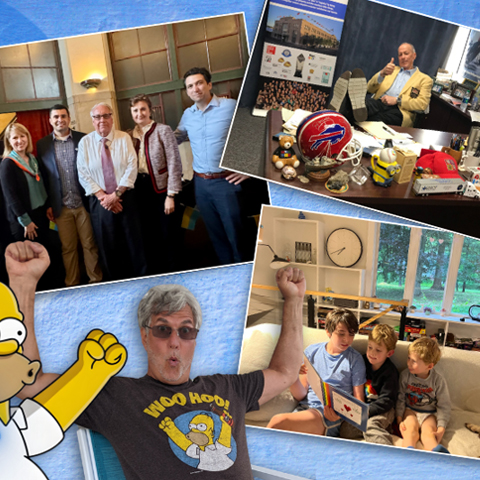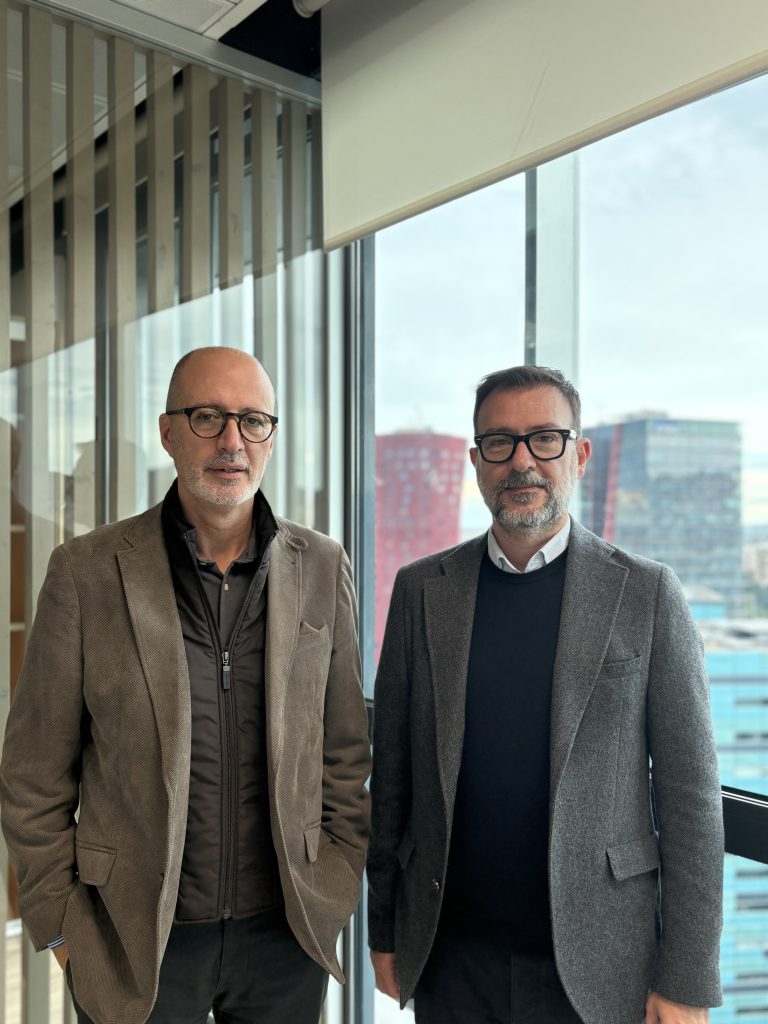
by Ryan Markiewicz | Dec 23, 2025 | News

Logistics Plus Brazil Achieves Authorized Economic Operator (AEO) Accreditation
The accreditation recognizes Logistics Plus Brazil for meeting stringent international trade standards.

(Click to view the certificate)
ERIE, PA (December 23, 2025) – Logistics Plus, Inc. (LP), a global leader in transportation, logistics, and unique supply chain solutions, is proud to announce that Logistics Plus Brazil has been officially accredited as an Authorized Economic Operator (AEO) under Brazil’s Authorized Economic Operator (Operador Econômico Autorizado – OEA) Program.
The accreditation, issued by Brazil’s Special Secretariat of the Federal Revenue, recognizes Logistics Plus Brazil (LP Brazil) for meeting stringent international standards related to supply chain security, regulatory compliance, risk management, and operational reliability. The certification was granted on December 19, 2025, and is valid for an indefinite period.
The Brazilian AEO Program is part of a global framework promoted by the World Customs Organization (WCO) to strengthen supply chain security while facilitating legitimate trade. Companies granted AEO status benefit from simplified customs procedures, reduced inspections, and faster clearance times — advantages that directly translate into greater efficiency and predictability for customers.
“This accreditation reinforces our long-term commitment to compliance, security, and operational excellence in Brazil,” said Frederico Resende, Managing Partner of LP Brazil. “As global supply chains continue to evolve, programs like AEO help ensure our customers benefit from smoother trade flows, reduced risk, and a higher level of trust when moving goods into and out of key international markets.”
LP Brazil operates as a full-service freight forwarder, supporting customers with international air and ocean freight, customs coordination, project cargo, and complex supply chain solutions throughout Brazil and the broader Latin American region. Achieving AEO status further strengthens the company’s ability to support multinational customers with compliant, resilient, and secure logistics operations.
The accreditation also aligns with broader global compliance initiatives at Logistics Plus, complementing similar trusted trader and security programs across other regions worldwide.
Visit br.logisticsplus.com to learn more about LP Brazil.
About Logistics Plus, Inc.
Logistics Plus, Inc. is a 21st Century Logistics Company™. With annual global sales approaching $1 billion, Logistics Plus is a leading global provider of transportation, warehousing, fulfillment, logistics, project management, business intelligence, technology, and unique supply chain solutions. The company is recognized as one of the fastest-growing privately owned logistics companies, with a presence in over 50 countries worldwide. With its trademark Passion for Excellence™, Logistics Plus is consistently recognized as a great place to work and a top global logistics provider. Learn more at logisticsplus.com.




by Ryan Markiewicz | Dec 16, 2025 | Berlin's Wall
All,
As you know, I usually try to keep Berlin’s Wall light. And in a way, this one is still about light — light amid darkness.
Most of you have likely read about the horrific shooting at Bondi Beach, Australia, which took place on the first night of Hanukkah — the literal Festival of Light.
More than 16 people were killed, including a 10-year-old girl and an 87-year-old man, and dozens more were injured.
But amid that darkness, there were moments of light.
Many of us have seen the heroic actions of Ahmed al-Ahmed, a Muslim refugee from Syria who emigrated to Australia years ago and built a new life there. When he saw the gunman, Ahmed charged him, wrestled him to the ground, and was shot in the process.
https://www.cnn.com/2025/12/14/world/video/bondi-gunman-tackle-digvid
What you may not have seen is the equally courageous act by Boris and Sofia Gurman, a Jewish couple originally from Russia who had also made Australia their home. When Boris, 69, saw the gunman step out of his car with a weapon, he didn’t run. He attacked. Sofia was right there with him. They became the first two victims of the massacre.
https://www.cnn.com/2025/12/16/world/video/dashcam-bondi-beach-couple-ripley-digvid
One man Muslim. One man Jewish.
Different histories. Different faiths. Same instinct. To step forward. To do the right thing. Even when the odds were overwhelming.
This isn’t about Muslims or Jews. It’s about good people — of all faiths and backgrounds — choosing courage over fear.
Also, please keep in mind that both men were immigrants — people who came to a new country, built lives, raised families, and in a moment of crisis showed extraordinary moral clarity.
There are never easy answers to the hard questions this world keeps throwing at us. But these actions — and the paths that led these people to that moment — are worth holding onto as a reminder of what light really looks like. And, hopefully, that helps give each of us the courage to do the right thing and to find the best way forward whenever it’s our time as well.
-Jim Berlin

by Ryan Markiewicz | Dec 10, 2025 | News
Holiday Shipping & E-Commerce: What Shippers Need to Know
 The holiday season is here, and with it comes one of the busiest shipping periods of the year. From Thanksgiving through Christmas, U.S. parcel carriers are projected to deliver over 2.3 billion packages, about a 5% increase compared to last year. That’s a lot of boxes moving through already-stretched-thin networks.
The holiday season is here, and with it comes one of the busiest shipping periods of the year. From Thanksgiving through Christmas, U.S. parcel carriers are projected to deliver over 2.3 billion packages, about a 5% increase compared to last year. That’s a lot of boxes moving through already-stretched-thin networks.
What’s driving the growth?
- An extra shopping day compared to 2024 is giving retailers a slight boost.
- E-commerce continues to dominate, with online holiday sales expected to rise 7%–9%.
- “Buy online, ship to home” remains the preferred gift-buying method, especially for last-minute shoppers.
For shippers, this means holiday surcharges, delivery cutoffs, and congestion are real concerns. If you’re shipping gifts or customer orders, plan early and communicate deadlines clearly.
Christmas Trees: Real vs. Artificial
The holiday centerpiece is changing. While U.S. households historically purchased 25–30 million real trees annually, a recent survey shows 83% of households will choose artificial trees this year. Why? Convenience, reusability, and cost-effectiveness are winning over tradition.
For those sticking with real trees, good news: 84% of growers do not plan to raise wholesale prices, keeping natural trees affordable despite inflationary pressures.
Holiday Spending Trends
 Retail spending is expected to grow modestly, 2.3% to 3.3% compared to last year. E-commerce is the bright spot, with online sales projected to jump 7%–9%. This shift means retailers and small businesses must focus on:
Retail spending is expected to grow modestly, 2.3% to 3.3% compared to last year. E-commerce is the bright spot, with online sales projected to jump 7%–9%. This shift means retailers and small businesses must focus on:
- Clear shipping deadlines
- Transparent return policies
- Proactive customer communication
What This Means for Logistics
The surge in holiday shipping puts pressure on capacity, timing, and reliability. For businesses, this is the season to:
- Ship early to avoid delays and surcharges.
- Leverage logistics partners who can navigate carrier constraints.
- Optimize fulfillment strategies for speed and cost efficiency.
At Logistics Plus, we help businesses stay ahead of seasonal challenges with flexible solutions, global reach, and personalized service. Whether it’s parcel, freight, or last-mile delivery, we make sure your holiday logistics run smoothly so that you can focus on delighting customers.
Ready to Ship Smarter This Season?
Contact Logistics Plus today for customized shipping solutions that keep your business moving during the busiest time of the year.


by Ryan Markiewicz | Dec 5, 2025 | News
 Jim Berlin, Founder and CEO of Logistics Plus (LP), was featured on the Business Spotlight program, which is produced in partnership with WPSE Money Radio. Business Spotlight is a monthly 30-minute program that airs regionally and streams globally.
Jim Berlin, Founder and CEO of Logistics Plus (LP), was featured on the Business Spotlight program, which is produced in partnership with WPSE Money Radio. Business Spotlight is a monthly 30-minute program that airs regionally and streams globally.
In this special segment, Jim looks back on 2025, highlights the company’s growth and success, and discusses the challenges faced over the past year. He also shares insights into upcoming opportunities, what he expects in 2026 and beyond, and much more.
You can listen to a replay of the interview on the Logistics Plus Podcasts page or by clicking below on our LP Radio channel on Spotify.

by Ryan Markiewicz | Nov 25, 2025 | News

Salvador Martín and Frederic Solàs
Logistics Plus (LP) Spain is pleased to announce that it is continuing its rapid growth with the opening of a new office in Madrid. This expansion comes shortly after the successful launch of the new LP Spain division in Barcelona and reflects the company’s commitment to strengthening its presence across the Iberian Peninsula. The expansion is being led by Logistics Plus Spain’s CEO, Salvador Martín, and Managing Director, Frederic Solàs, whose extensive industry experience and strong local relationships continue to drive momentum for the new division. Additionally, Logistics Plus Spain would like to introduce Amparo Buenache as the Branch Manager for the Madrid office.
LP Spain offers end-to-end logistics solutions, including:
- International ocean and air freight forwarding
- Project logistics
- Ground transportation
- Customs clearance
Madrid is one of Europe’s most important transportation and logistics hubs, offering excellent road, rail, and air connectivity. Establishing a physical presence in the capital will allow LP Spain to better support key customers, accelerate regional growth, and further integrate with the broader Logistics Plus European network. With the addition of an office in Madrid, Logistics Plus now enhances its already robust European operations, working closely with teams across the region.
 Logistics Plus, Inc. (Madrid, Spain)
Logistics Plus, Inc. (Madrid, Spain)
C/ Alcarria 7 28821 Coslada
Madrid, Spain
For any requests involving our Spain offices, please email spain@logisticsplus.com. We appreciate your current business and look forward to exploring future opportunities with you.

Page 1 of 3812345...102030...»Last »







 The holiday season is here, and with it comes one of the busiest shipping periods of the year. From Thanksgiving through Christmas, U.S. parcel carriers are projected to deliver over 2.3 billion packages, about a 5% increase compared to last year. That’s a lot of boxes moving through already-stretched-thin networks.
The holiday season is here, and with it comes one of the busiest shipping periods of the year. From Thanksgiving through Christmas, U.S. parcel carriers are projected to deliver over 2.3 billion packages, about a 5% increase compared to last year. That’s a lot of boxes moving through already-stretched-thin networks. Retail spending is expected to grow modestly, 2.3% to 3.3% compared to last year. E-commerce is the bright spot, with online sales projected to jump 7%–9%. This shift means retailers and small businesses must focus on:
Retail spending is expected to grow modestly, 2.3% to 3.3% compared to last year. E-commerce is the bright spot, with online sales projected to jump 7%–9%. This shift means retailers and small businesses must focus on:




 Logistics Plus, Inc. (Madrid, Spain)
Logistics Plus, Inc. (Madrid, Spain)